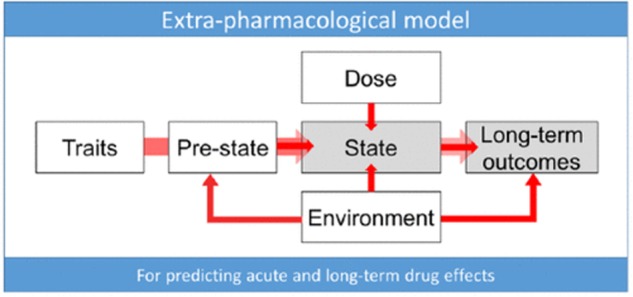FIGURE 1.

‘Extra-pharmacological’ factors that can determine psychedelic drug effects (Carhart-Harris and Nutt, 2017). “Trait factors may be biological [e.g., receptor polymorphisms (Ott, 2007)] or psychological in nature [e.g., personality (MacLean et al., 2011) or suggestibility (Carhart-Harris et al., 2015)]. The pre-state refers to such things as anticipatory anxiety, expectations and assumptions (which account for so-called ‘placebo’ and ‘nocebo’ effects), and readiness to surrender resistances and ‘let go’ to the drug effects (e.g., see Russ and Elliott, 2017). In the context of psychedelic research, the pre-state is traditionally referred to as the ‘set’ (Hartogsohn, 2016). State refers to the acute subjective and biological quality of the drug experience and may be measured via subjective rating scales or brain imaging (see Roseman et al., 2017). Dose relates to the drug dosage—which may be a critical determinant of state (Griffiths et al., 2011; Nour et al., 2016)—as well as long-term outcomes (see Roseman et al., 2017). Environment relates to the various environmental influences. In the context of psychedelic research this is traditionally referred to as ‘setting’ (Hartogsohn, 2016). We recognize that the environment can be influential at all stages of the process of change associated with drug action. The long-term outcomes may include such things as symptoms of a specific psychiatric condition such as depression—measured using a standard rating scale (Carhart-Harris et al., 2016a) as well as relatively pathology-independent factors such as personality (MacLean et al., 2011) and outlook” (Carhart-Harris and Nutt, 2017, p. 1097).
